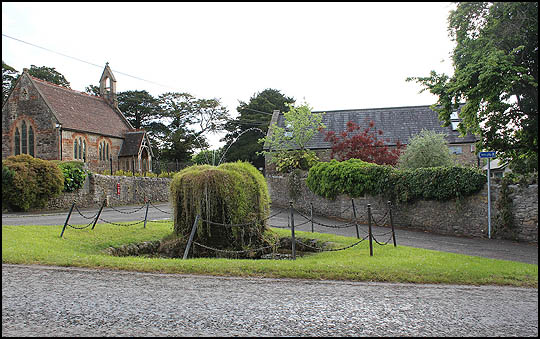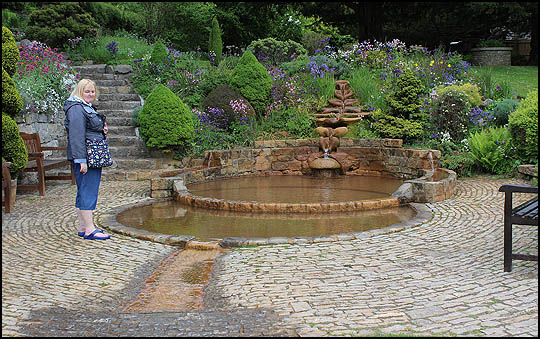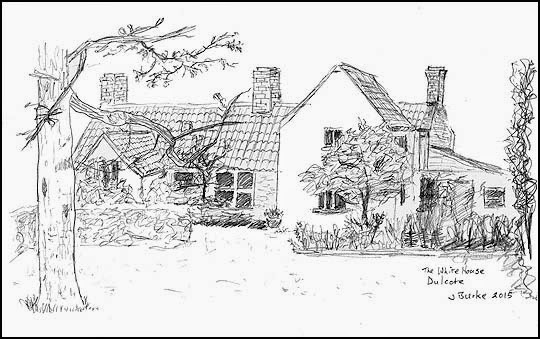Sunday 24 May 2015. Mary and Rod at the White House B&B had warned us that the road through the village of Dulcote was due to be closed from 9:30am due to a running event, so we opted for a fairly early (and mouth-wateringly huge and lush!) breakfast in order to be able to get the car out and away. We drove a short distance to Glastonbury and went into the famous abbey.
We found some sort of event taking place. After paying and starting out in the small museum there was a woman dressed in the costume of a medieval peasant standing looking at us but not saying anything. "Are you real?" I asked pleasantly, not wanting ghosties phasing through me just after eating Mary's massive breakfast - it would put me right off... Anyway... she was real!

The two eastern piers of the abbey's crossing. The western piers have both fallen and only a single stone foundation exists of them. The majority of the abbey buildings have been lost, but there are some quite spectacular things to see here.

The main Abbey church seen from the chancel. The chained area marks where the High Altar once stood. Seen between the piers is the Lady Chapel, of which more later. Beside the Lady Chapel, in 1191 the monks of the abbey claimed to have unearthed the body of a huge man with his wife in a coffin made from a single hollowed out oak tree trunk. They announced that it was King Arthur and Guinevere his queen. This has to be set against the fact that the abbey had burned down in 1184 and they were desperate to have the money for rebuilding that hordes of pilgrims would bring.

The sign reads: "Site of King Arthur's tomb. In the year 1191 the bodies of King Arthur and his Queen were said to have been found on the south side of the Lady Chapel. On 19th April 1278 their remains were removed in the presence of King Edward I and Queen Eleanor to a black marble tomb on this site. This tomb survived until the dissolution of the abbey in 1539."

To the east of the abbey, the grounds contain areas of protected wild flowers and an arboretum. Even such a committed non-gardener as myself, whose most exuberant uttering on looking at the most luxurious flower specimen would be "that's nice..." could enjoy the walk through trees, past shrubs and signs warning of badger setts and mole holes. Despite some rather dullish weather, we walked around the entire perimeter.

The abbey pond. Fish were spawning and causing swirls and splashes in the water as they broke the surface in their mating.
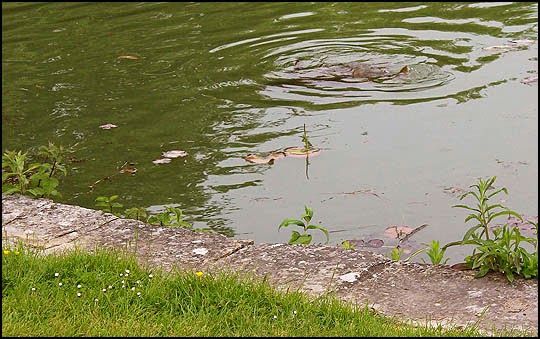

A number of people were breaking camp in this area, having spent the night under canvas, or at least under some sort of thin material with a long chemical name, whatever it is they make tents with these days. They were happily calling to each other in German or Dutch or some other language that was beyond me, saying things like "If you go for a dip in the pond, dear, don't come back with your shorts full of pond weed like yesterday..."
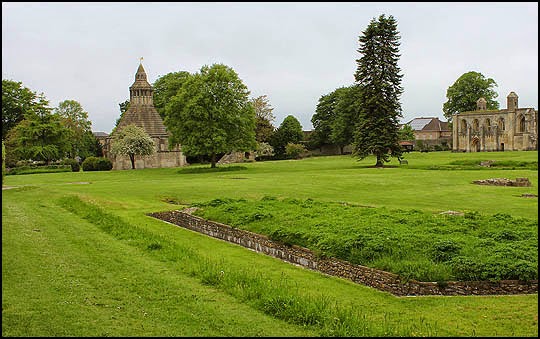
We are returning back down towards the visible bits of the abbey again. This is the view from the south side of the abbey showing the Bishop's Kitchen towards the left.

This is by far the best preserved building of the abbey and is one of the best preserved of all medieval kitchens in Europe. It was built as part of the abbot's house, during the tenure of Abbot John de Breyton (1334-42).

Inside are little tableaux set out to show how the kitchen might have appeared during medieval times. I suspect a great many people might have been running about and working here! This was a preparation area, not a dining area. In another corner were little waxwork roasting porkers, complete with wounds from arrows, skewered above a "fire" which does glow and emits little gasps of "smoke" and also a bacon smell!

A glance up a chimney though reveals a mass of spiders' webs who wouldn't have hung about so much when fires really did blaze below! In yet another corner a deep oven is set into the wall. Bread would have been a staple of the monks' diet, though no doubt in the Bishop's House a rather more splendid fare was available.

We exited the Bishop's Kitchen on the opposite side to which we entered and a fragment of masonry allowed me to climb to a railed area for an elevated viewpoint.

Unfortunately the Bishop's House has not fared so well as the kitchen. But we do know from archeological evidence that there was a sumptuous guest house attached to it that was built for the royal visit of King Henry VII - a king who had claimed his throne in battle against Richard III and who spent the rest of his life watching for and imagining acts of vengeance and treachery on every side. It would have been much safer to have made a fuss of him with a huge welcome!

Here we are looking north towards the Lady Chapel across what was a cemetery - the cemetery where the grave of King Arthur and Guinevere was found, buried at a great depth between two pyramid structures. The female skeleton still had long blonde hair attached to the skull but it disintegrated on being touched. A lead cross lay over them according to the records with an inscription that brooked no doubt: "Hic jacet sepultus inclitus rex Arthurus in insula Avalonia" - "Here lies buried the renowned King Arthur in the Isle of Avalon".
1194 is 641 years after the claimed date for the Battle of Camlann in which Arthur was reportedly slain. The find is almost directly comparable to the 21st century finding of the burial of King Richard III, in that very similar amounts of time passed between burial and discovery. Yet the monks at Glastonbury had no sophisticated tests to verify the identity of the remains, nor cameras to record it. Their search is sometimes reported as being at the behest of King Henry II following his interpretation of a tradition told to him by a Welsh bard and sometimes as having been ordered by the Abbot Henry de Sully.
The bones of whoever it was they claimed to have dug up were lost forever when Henry VIII threw his hissy fit at the Pope and Catholicism and destroyed all evidence that might have remained. The tomb and its contents have never been heard of since the Dissolution. The Abbot at the time, Richard Whyting tried to stop the desecration and for his efforts was taken on 15 November 1539 to the nearby Tor and there was hung, drawn and quartered.

On the interior walls of the Lady Chapel, built very soon after the finding of the Arthurian remains, there are still traces of paint from a very sumptuous decoration that adorned the entire interior with colour and design. There are also traces of ancient graffiti...


The Glastonbury Thorn. Or rather, one of the thorn trees, said to have originated from the staff of Joseph of Arimathea, the uncle of Jesus Christ who donated his own tomb to hold the body of Christ after the Crucifixion. It is said he stopped to rest on Wearyall Hill above Glastonbury and when he awoke next morning his staff, which he had pushed into the ground, had taken root and burst into blossom. This is one of several trees in Glastonbury grown from cuttings taken from the tree on Wearyall Hill.

We left the abbey and looked for somewhere to sit down for a coffee. There are lots of places available but I do have a liking for the more traditional tea rooms and we found one called "The Abbey Tea Rooms". We went in, sat down, ordered and got a coffee and sat watching the Heavens open...
Links
Glastonbury Abbey: www.glastonburyabbey.com
Glastonbury Abbey Shop: www.glastonburyabbeyshop.com
The Abbey Tea Rooms: abbeytearooms.co.uk
King Arthur (Wikipedia): en.wikipedia.org/wiki/King_Arthur
King Arthur (BBC History): www.bbc.co.uk/history/ancient/anglo_saxons/arthur_01.shtml
King And King To Be (Kindle book by this blog's author): www.amazon.co.uk/dp/B008BL7HUG
Other articles referring to King Arthur: on this blog
Somerset Weekend Index






